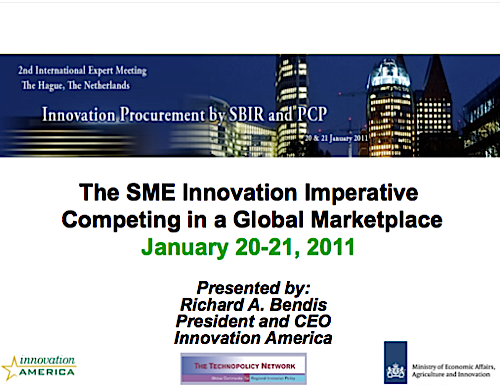 It's pretty amazing what kinds of things can get airborne with enough engines, wings, effort, determination or just sheer creativity. The last hundred years or so have provided a treasure trove of absolutely wild designs, and we've dug deep into the archives to come up with 26 of our favorites.
It's pretty amazing what kinds of things can get airborne with enough engines, wings, effort, determination or just sheer creativity. The last hundred years or so have provided a treasure trove of absolutely wild designs, and we've dug deep into the archives to come up with 26 of our favorites.
Now, the category of "things that fly" is pretty broad, so before you get all outraged that we didn't include something, here are the rules: This list isn't going to include hovercraft or ground effect vehicles or anything that wasn't capable (or at least had the intention) of getting airborne and flying at altitude for sustained periods of time.
innovation DAILY
Here we highlight selected innovation related articles from around the world on a daily basis. These articles related to innovation and funding for innovative companies, and best practices for innovation based economic development.
How Latin American startups are tapping into Silicon Valley
 When I worked for Intel Capital, Intel’s corporate venture capital (VC) arm, in Mexico and a bit in Brazil ten years back, the big issue in Latin America was finding enough deals from which to select investment opportunities. Today, that is less of an issue in a country such as Brazil that has an incredibly vibrant start-up environment, but it’s still a concern in my current home country, Colombia.
When I worked for Intel Capital, Intel’s corporate venture capital (VC) arm, in Mexico and a bit in Brazil ten years back, the big issue in Latin America was finding enough deals from which to select investment opportunities. Today, that is less of an issue in a country such as Brazil that has an incredibly vibrant start-up environment, but it’s still a concern in my current home country, Colombia.
Latin America’s been my home for the last 15 years, and I’ve frequently heard people talking about creating something like Silicon Valley here. But I think it makes more sense for Latin America to tap directly into the Valley’s expertise, culture and established networks. That’s a major reason I decided to become the facilitator for the new Bogota, Colombia chapter of startup incubator Founder Institute.
O'Malley: $100 million plan to invest in technology, innovation businesses in Maryland
 Hoping to spur jobs, innovation and economic growth, Gov. Martin O'Malley wants to tap tax revenue to invest $100 million in fledgling technology, life sciences and other companies across the state.
Hoping to spur jobs, innovation and economic growth, Gov. Martin O'Malley wants to tap tax revenue to invest $100 million in fledgling technology, life sciences and other companies across the state.
O'Malley, a Democrat, plans to unveil details of the "Invest Maryland" program Monday as a centerpiece of his economic agenda in this year's General Assembly session. The state would invest in small businesses and start-up companies — partially through the dormant Maryland Venture Fund — and would reap both the risks and rewards.
4 Ways to Repurpose Content to Attract Links to Your Website
 Link building is one of the cornerstones of SEO. Essentially, the more high-quality material that links back to your website, the more clout your website gets in the search engines and the higher you’ll rank in the Google war for first-page placement. The more one-way links from quality sources you have, the higher your website authority and the better your rankings.
Link building is one of the cornerstones of SEO. Essentially, the more high-quality material that links back to your website, the more clout your website gets in the search engines and the higher you’ll rank in the Google war for first-page placement. The more one-way links from quality sources you have, the higher your website authority and the better your rankings.
It sounds great, but bolstering the amount of links pointing to your site can be a difficult thing to do. One way is to write high-quality articles with links pointing back to your site and submit them to article directories such as ezinearticles. The problem here is the time that has to be sunk into creating these quality articles – either you have to write them yourself or pay somebody else to write them for you, and each one may only generate one new link. This can be time-consuming or extremely expensive, and there are only a finite number of publishers who will accept your content.
Ten Golden Insights From Successful Entrepreneurs
 Entrepreneurs are a notoriously stubborn (some say confident) group of people, so I see many of them making the same mistakes that predecessors have made. Thus I’m convinced that it’s useful for all of you to step back from time to time, and listen to some sage advice from people who have been there and enjoyed success.
Entrepreneurs are a notoriously stubborn (some say confident) group of people, so I see many of them making the same mistakes that predecessors have made. Thus I’m convinced that it’s useful for all of you to step back from time to time, and listen to some sage advice from people who have been there and enjoyed success.
Recently, as I was perusing a new book by Robert Jordan, titled “How They Did It: Billion Dollar Insights” I saw some wisdom and inspiration that made sense. All the quotes come from entrepreneurs who have built and sold at least one $100 million company.
Thomson Reuters Releases Report on the State of Global Innovation
 Innovation levels, as measured by patent volume, shifted across 12 major technology areas from 2009 to 2010, according to the second annual analysis of world patent activity published by the IP Solutions business of Thomson Reuters. The 2010 Innovation Report: Twelve Key Technology Areas and Their States of Innovation tracks patent activity in key technology areas using the Thomson Reuters Derwent World Patents Index® (DWPISM) database, the world’s most trusted source of patent information.
Innovation levels, as measured by patent volume, shifted across 12 major technology areas from 2009 to 2010, according to the second annual analysis of world patent activity published by the IP Solutions business of Thomson Reuters. The 2010 Innovation Report: Twelve Key Technology Areas and Their States of Innovation tracks patent activity in key technology areas using the Thomson Reuters Derwent World Patents Index® (DWPISM) database, the world’s most trusted source of patent information.
Key findings between 2009 and 2010 innovation data include:
* Aerospace technology area blasts into a new orbit: In addition to increasing overall activity by 25% year over year, the largest aerospace subsector increase from 2009 to 2010 occurred in the field of Space Vehicles and Satellite Technology, which jumped up 108%. The three companies in this area were Japanese manufacturer Sharp, followed by Korean manufacturers LG and Samsung.
EIT: European Institute of Innovation and Technology
V ision
ision
The European Institute of Innovation and Technology (EIT) is to be a key driver of sustainable European growth and competitiveness through the stimulation of world-leading innovations with a positive impact on economy and society.
Mission
The mission of the EIT is to grow and capitalise on the innovation capacity and capability of actors from higher education, research, business and entrepreneurship from the EU and beyond through the creation of highly integrated Knowledge and Innovation Communities (KICs).
2011 Telecommunications Industry Perspective
 The coming year will be a challenging one for telecom operators. As they continue to build high-speed fixed and mobile networks, and search for continued growth in the form of high-value services and applications, competition from companies outside the traditional telecom industry boundaries will increase. So operators will have to become both more efficient and more innovative, and learn to take advantage of their many inherent advantages. We also expect increased M&A activity as companies look to add scale and services.
The coming year will be a challenging one for telecom operators. As they continue to build high-speed fixed and mobile networks, and search for continued growth in the form of high-value services and applications, competition from companies outside the traditional telecom industry boundaries will increase. So operators will have to become both more efficient and more innovative, and learn to take advantage of their many inherent advantages. We also expect increased M&A activity as companies look to add scale and services.
Download the PDF
IT'S OFFICIAL: College Students Learn Next To Nothing
 With millions of people out of work in this country -- many who have college degrees and even advanced degrees -- rising tuition costs have many wondering if college students are getting the bang for their parents' buck. (See: Rethinking College as Student-Loan Burdens Rise)
With millions of people out of work in this country -- many who have college degrees and even advanced degrees -- rising tuition costs have many wondering if college students are getting the bang for their parents' buck. (See: Rethinking College as Student-Loan Burdens Rise)
A new study suggests, “not hardly,” if the goal of earning a four-year college degree is to actually learn something.
The report based on the book Academically Adrift: Limited Learning on College Campuses found that after two years of college, 45% of students learned little to nothing. After four years, 36% of students learned almost nothing.
The Healing Power of Light
 A new polymer material that can repeatedly heal itself at room temperature when exposed to ultraviolet light presents the tantalizing possibility of products that can repair themselves when damaged. Possibilities include self-healing medical implants, cars, or even airplane parts.
A new polymer material that can repeatedly heal itself at room temperature when exposed to ultraviolet light presents the tantalizing possibility of products that can repair themselves when damaged. Possibilities include self-healing medical implants, cars, or even airplane parts.
The polymer, created by researchers at Carnegie Mellon University and Kyushu University, heals when a crack in the material is pressed together and exposed to UV light. The same treatment can cause separate chunks of the material to fuse together to form one solid piece.
5 business myths to ditch for small business owners
 FORTUNE -- Feeling a little disillusioned lately? That's not a bad thing if you're an entrepreneur. There's nothing like humbling economic times to force chief executives to let go of the sacred-cow ideas and grandiose illusions they've been harboring and start building on reality. Some of the smartest business owners I know have fallen for these five myths. Ditch them. It will make your business that much stronger.
FORTUNE -- Feeling a little disillusioned lately? That's not a bad thing if you're an entrepreneur. There's nothing like humbling economic times to force chief executives to let go of the sacred-cow ideas and grandiose illusions they've been harboring and start building on reality. Some of the smartest business owners I know have fallen for these five myths. Ditch them. It will make your business that much stronger.
1. Gross margins will grow as you get bigger
Not so. My research shows that they typically dip. That was a tough lesson for Jennifer Olsen Welding, who owns a 70-employee Salt Lake City casting company. Her tale: Unlimited Designs won a municipal contract to create a precast building façade in 2009. The trouble was, the $5 million company had to lease extra equipment to do the job. Sales increased significantly, and gross margins declined by 3%. "We would have been better off having no revenue than the revenue that was coming in," she says.
4 ways to boost collaboration in a remote work environment
 You hear a lot about the importance of collaboration in the business environment, but what happens when an executive can’t just pop into a colleague’s office to hash through a big idea? And how do managers maintain interpersonal connections when their employees span different time zones and geographies?
You hear a lot about the importance of collaboration in the business environment, but what happens when an executive can’t just pop into a colleague’s office to hash through a big idea? And how do managers maintain interpersonal connections when their employees span different time zones and geographies?
As more organizations move towards satellite offices or a remote workforce model to reduce costs and acquire top-tier talent from other locations, it’s a problem that’s only going to grow.
How You May be Signaling Price without Knowing It
 I was having a chat with an entrepreneur who I really like and who I try to mentor from time-to-time. He has an interesting business and one that has a viable shot at being an innovative & profitable business.
I was having a chat with an entrepreneur who I really like and who I try to mentor from time-to-time. He has an interesting business and one that has a viable shot at being an innovative & profitable business.
One problem. He’s struggling to raise money. This is extra frustrating in an era in which all you read about is how frothy the VC / funding market is these days. People are raising in record times and with wacky valuations. It is not an uncommon story that this is happening but others are struggling.
Want to Keep Key Employees? Learn From the Talent Masters
 As the economy gets better, holding on to your peak-performing employees is going to get harder and harder. You obviously can’t (or may not want to) hold on to all of your workers, but if one of your key players heads out the door, your small business could be in a tough spot.
As the economy gets better, holding on to your peak-performing employees is going to get harder and harder. You obviously can’t (or may not want to) hold on to all of your workers, but if one of your key players heads out the door, your small business could be in a tough spot.
So how do you keep top-notch employees? One way to learn is from the “talent masters.” The Talent Masters is the title of a recent book by Bill Conaty (formerly head of HR at General Electric) and Ram Charan, a business advisor, speaker and author who has coached some of the world’s most successful CEOs. The Economist recently took a look at some of the lessons from the book, which studied companies known to be “talent factories,” including GE and Procter & Gamble.
FDI Perspectives: Issues in International Investment.
 Vale Columbia Center on Sustainable International Investment is today releasing FDI Perspectives: Issues in International Investment. The 30 chapters in this volume, written by diverse experts on international investment, cover a wide range of issues in this field. Their purpose is to inform readers in a concise manner about some of the important issues and trends in the contemporary debate on FDI and to promote a wide-ranging discussion about the policy implications of major trends and events.
Vale Columbia Center on Sustainable International Investment is today releasing FDI Perspectives: Issues in International Investment. The 30 chapters in this volume, written by diverse experts on international investment, cover a wide range of issues in this field. Their purpose is to inform readers in a concise manner about some of the important issues and trends in the contemporary debate on FDI and to promote a wide-ranging discussion about the policy implications of major trends and events.
http://www.vcc.columbia.edu/files/vale/content/PerspectivesEbook.pdf
Harvard professor, Michael E. Porter: Capitalism not all that
 When a business brain like Michael E. Porter talks, people listen. He’s a Harvard Professor with 18 books published to his name and is believed to be the most cited author in business and economics (according to Wikipedia).
When a business brain like Michael E. Porter talks, people listen. He’s a Harvard Professor with 18 books published to his name and is believed to be the most cited author in business and economics (according to Wikipedia).
He also has some interesting views about capitalism.
In this interview by Harvard Business Review editor Adi Ignatius, Porter calls for the next evolution of capitalism to get going already.
Inc.'s Excellent Story on Entrepreneurship in Norway : CJR
 Max Chafkin has a fantastic story in Inc magazine about how to structure an economy so as to encourage entrepreneurship, full employment, and general happiness and contentment, all while drastically reducing inequality. It’s easy, in fact: all you need to do is become Norway.
Max Chafkin has a fantastic story in Inc magazine about how to structure an economy so as to encourage entrepreneurship, full employment, and general happiness and contentment, all while drastically reducing inequality. It’s easy, in fact: all you need to do is become Norway.
There’s loads of great stuff in this piece, and I’d encourage you to read the whole thing. But a few things stand out.
Chafkin starts with the tale of Wiggo Dalmo, an industrial mechanic with a high-school education who chafed under his bosses, set up his own shop, and is now running a $44 million company with 150 employees. That’s the kind of story which should be common in the US but is in fact rare. But ask yourself: in the US, how much would such a person be paying in taxes? Dalmo paid $102,970 in personal taxes on his income and wealth last year, which is probably lower, not higher, than the CEO of a $44 million company would pay in taxes in the US.



